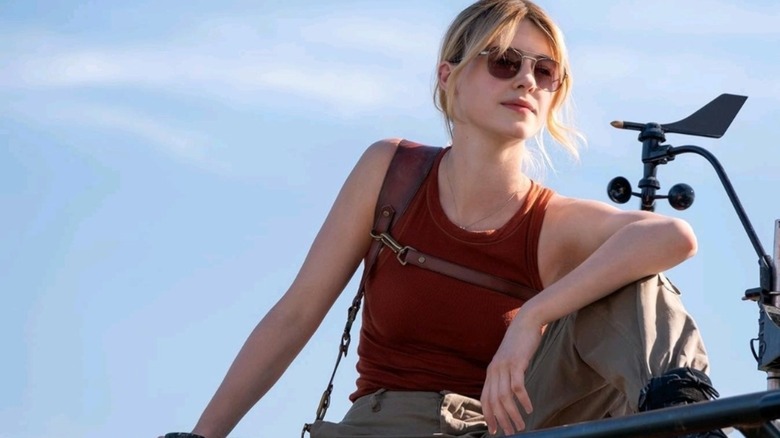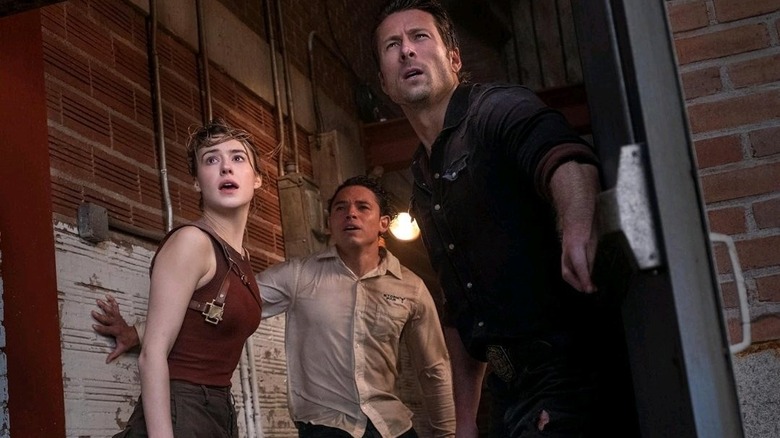Twisters Secured An Increasingly Rare Filmmaking Privilege Thanks To Steven Spielberg
When Jan de Bont's "Twister" was released in 1996, it was warmly but not enthusiastically greeted by critics. Some praised its atmosphere and colorful characters, and most were impressed with the film's expensive digital VFX, the extensive use of which was considered novel at the time. However, just as many critics pointed out that the script (by Michael Crichton and Anne-Marie Martin) was a little generic and the plot was unbearably simple. Audiences flocked to "Twister," though, and the film ultimately made over $495 million worldwide. "Twister" is not a great work of cinema, but it bears a lot of goodwill.
Fast-forward to 2024, and all the criticisms of "Twister" might also be applied to Lee Isaac Chung's "Twisters," the new quasi-sequel to the first film. "Twisters" offers no dramatically new spin on de Bont's original, playing lightly with a similar tone of lightweight meaninglessness. The characters are equally empty, but also equally charming; Glen Powell in particular has a cinematic dazzle that is well employed. It was a distinct change of pace for director Chung, whose 2020 film "Minari" was subtle, understated, and emotionally intense.
Both films, one might note, possess a palpable visual texture. De Bont worked as a cinematographer for most of his career, and likely had many conversations with his DP, Jack N. Green, about capturing light correctly. The DP for "Twisters" was Dan Mindel, the photographer for many of J.J. Abrams' movies. In an increasingly rare privilege in the modern age, Mindel shot "Twisters" on 35mm film, mostly to capture the same look as the 1996 original. Chung recently spoke to The Hollywood Reporter about his choice to use 35mm, and how he wouldn't have been allowed to had Steven Spielberg not served as an executive producer.
Shooting on 35mm film in 2024
Actual physical celluloid film is a rarity in the digital age. Around 2011, most theaters ditched their film-based equipment and switched to digital projection. Also by 2011, digital cameras had grown sophisticated enough to handle the same visual fidelity as 35mm film, and many modern studios swapped out their tech. Only a small handful of filmmakers — Quentin Tarantino, P.T. Anderson, Christopher Nolan, a few others — still make it a point to shoot on film as often as possible.
But many filmmakers prefer the heft and visual timbre of 35mm film, and Chung was eager to switch to celluloid to make "Twisters." Working with film, however, requires more time than shooting on digital, as dailies need to be developed by a lab before they can be reviewed. Studios dislike the delays, having become accustomed to the instant gratification of digital. Chung stuck by his guns, however, and insisted. And once Spielberg made a call to Universal, Chung was permitted to shoot however he wanted. He said:
"I felt like [shooting on film] was a bit of a battle, and I understand [Universal's] point of view. They want to reduce the unknown risks that exist within production, and film can often feel like an added element of the unknown. But I really love film. [...] So it basically took me working with Dan Mindel, and it also took Steven Spielberg coming on board and saying, 'Please let him shoot on film.' Those two factors really allowed things to open up for me, so I do credit it to them."
Despite the large amount of FX shots in "Twisters" (although don't expect to see a flying cow in this one), it was still filmed 100% on film. If it looks grittier and heftier and "more real" than expected, that would likely be the reason why.

